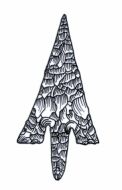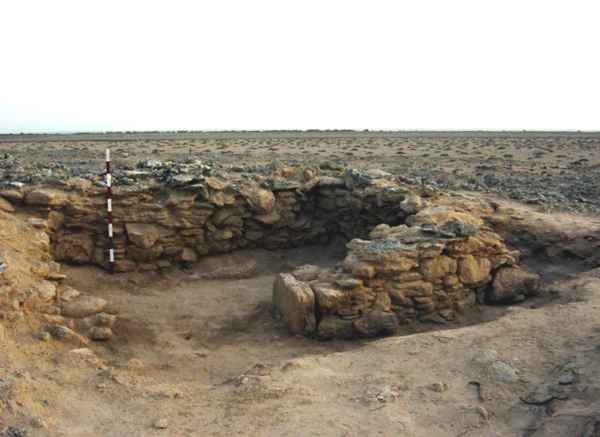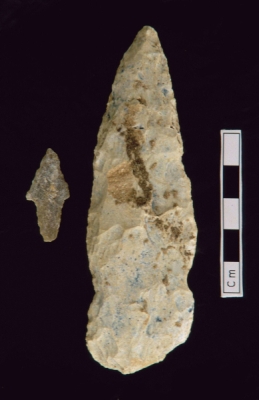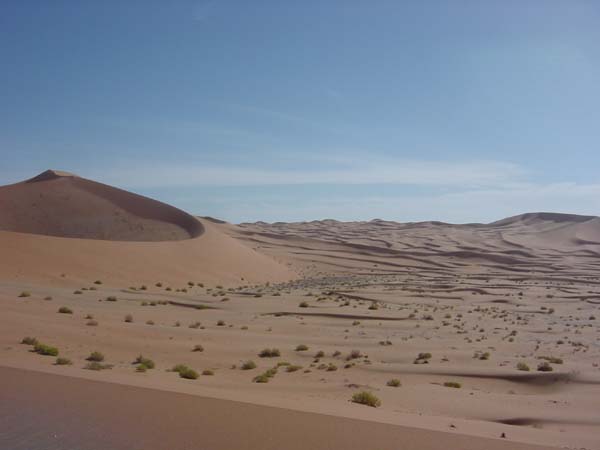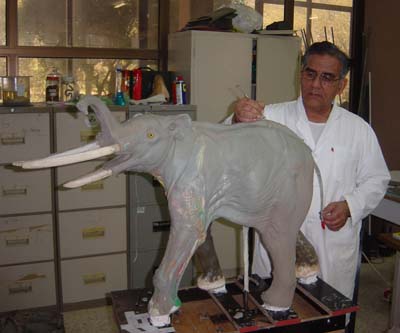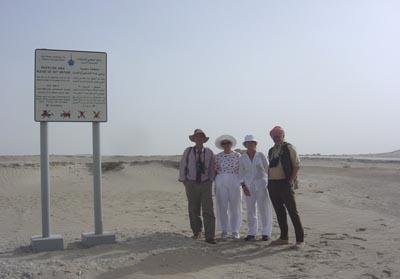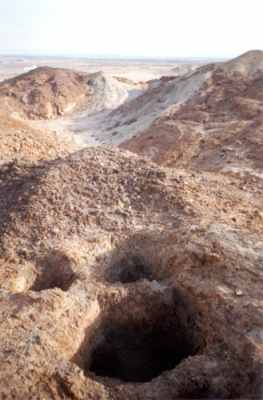The ADIAS
Occasional Newsletter is edited by Peter
Hellyer & Dr. Mark Beech. 7,000
year-old houses discovered on Marawah 7,000
year-old houses discovered on Marawah The discovery
was made by an ADIAS team working in association with the Environmental
Research and Wildlife Development Agency, ERWDA, who are responsible
for management of the island's wildlife and environment as part of the
Marawah
Marine Protected Area, MMPA. During
the excavations, a fine flint spear and flint arrowhead were found,
as well as a fragment of a stone pestle, probably used for grinding
food items.
Samples of ash were taken from the floors of two of the buildings, and
were sent to the Scottish
Universities Research and Reactor Centre at the University of Glasgow
in Britain, for radiocarbon dating. The results of the dating, recently
received by ADIAS, prove that the buildings were in use between 6,500
and 7,000 years ago. No stone-built houses dating to this particular
period are known from elsewhere in the UAE, although similar, but less
well-preserved, examples have been noted elsewhere in the Arabian peninsula
at Shagra in Qatar, and at Sabiyah in Kuwait. The importance
of Abu Dhabi's islands during the Late Stone Age is also underlined
by the results of ADIAS excavations on the island of Dalma
in 1993-4 and 1998. These uncovered traces of circular buildings constructed
with supporting timber posts. Analysis of the pottery and radiocarbon
dates from these, and other, sites has shown that around 7000 years
ago, there was extensive settlement on the offshore islands. The people
of the time were also trading by sea with Mesopotamia (modern-day Iraq),
the beginning of the UAE's well-established tradition of maritime trade.
A series of Neolithic (Late Stone Age) scatters of lithics (stone tools) will be mapped and further survey work carried out. The site were first identified by a team from the Terrestrial Environment Research Centre (TERC) of the Environmental Research and Wildlife Development Agency (ERWDA). Chris Drew and Ingrid Barcelo from TERC first noted the interesting scatters of flint material in this area and reported it to ADIAS. An initial reconnaissance of the area was then made by Dr Mark Beech (ADIAS Senior Resident Archaeologist) together with Dr John Stewart (ADIAS associate and Department of Anthropology, UCL, London), and Chris Drew (TERC/ERWDA). Following discussions with the Department of Antiquities and Tourism in the Diwan of the Abu Dhabi's Ruler's Representative in the Eastern Region, it was decided to carry out a joint programme of work in the area, which is part of the Eastern Region. Two weeks fieldwork
are planned for late January/early February 2004. It is planned that
the preliminary results of this work will be submitted as a paper to
the annual Seminar for Arabian
Studies conference, due to be held at the British
Museum in London from 22-24 July 2004.
We shortly expect to receive the final outwork for our Miocene diorama, life in Abu Dhabi 6-8 million years ago. This is being prepared by Gemma Larkin, the wife of Nigel Larkin, our expert fossil conservator. Support for
the costs of staging the exhibition have been kindly provided by TAKREER,
who have also funded the ADIAS work at the major fossil site near Ruwais,
ADCO, who supported fossil work in the early 1990s by a joint team from
London's Natural History Museum and Yale University, and BP, who also
supported the earlier work, and have provided logistics support for
ADIAS. Launch
of new ADIAS book The book was
officially launched at a reception to commemorate the 40th Anniversary
of ADCO's 1st Shipment, held at the Company's Jebel Dhanna terminal.
A copy of the book was presented to HE Yousef Omeir Bin Yousef, Secretary-General
of the Supreme Petroleum Council and Chief Executive Officer of ADNOC
by Peter Hellyer, Dr Mark Beech and Simon Aspinall.
This was followed by a field visit to a site known as Rumaitha site RM-7, around 40 km. south-west of Abu Dhabi. This is the easternmost exposure of the Late Miocene fossil deposits so far known along the Abu Dhabi coast. Valuable new fossil specimens were collected from the site including crocodile teeth and catfish skull fragments. Following the launch of the Jebel Dhanna sulphur mines book (see above) at the Jebel Dhanna terminal, another field visit was made with Caroline Adams on 17th December 2003 to the Ruwais fossil site. A nice specimen of a crocodile osteoderm was collected, as well as numerous small fossil fragments. Appropriately, Caroline Adams, and her husband, Dr. Terry Adams had been actively involved in the survey work on Late Miocene fossils undertaken by the Natural History Museum and Yale University in the early 1990s - work which was sponsored by ADCO, on the initiative of Terry Adams. ADIAS was also
delighted to be able to take Margot Dunne out to the Rumaitha site -
this was first identified during an archaeological baseline study of
the ADCO oilfields commissioned from ADIAS by her husband, Kevin Dunne.
Visit to
Jebel Dhanna sulphur mines  Dr Mark Beech at one of the newly discovered structures on Bazm al-Gharbi Survey carried out on Bazm al-Gharbi Dr Mark Beech and Simon Aspinall recently carried out a rapid archaeological survey of the island of Bazm al-Gharbi. This small island is located about 250km west of Abu Dhabi, at the western end of the chain of islands running from Abu al-Abyadh to Junana, Marawah and Liffiyah, forming the outer side of the Khor al-Bazm. The island had not previously been visited by ADIAS, and the survey work, carried out on 21st-22nd December, fills in an important gap in our expanding data on archaeological sites on Abu Dhabi's islands. A total of 55 archaeological sites were mapped on the island using GPS equipment. These sites varied from fire-pits and hearths to cairns and house structures. A small stone slab outline mosque was identified on the south-eastern coast of the island. A mysterious large building oriented north-south was also discovered towards the southern end of the island. The dimensions of this building were 22 x 17 metres. A large concentration of pottery was collected from an area immediately adjacent to this building. This pottery will shortly be examined to determine information on the dating of this enigmatic building.Whilst much of the pottery collected on Bazm al-Gharbi appears to belong to the so-called Late Islamic period, a number of sherds are not immediately recognisable. There remains the possibility that some of the sites identified from these surface pick-ups may be much older. Further work will be required on the analysis of the Bazm al-Gharbi pottery, and a further visit to the island will be undertaken in order to take ash/charcoal samples from some of the hearths for radiocarbon dating. This work was carried out with assistance and support from the staff of the Marine Environmental Research Centre at the Environmental Research and Wildlife Development Agency, ERWDA. In particular, Nasser Al-Shaiba and Falah Al-Ahbabi piloted the speedboats which took us over to the island for the survey. Whilst on the island, temporary loan of a quad bike was provided by a falcon trapper working on Bazm al-Gharbi for HH Sheikh Khalifa bin Zayed. New sponsors of ADIAS ADIAS is pleased to announce that it has recently received sponsorship from a number of major companies for our work in the current year. Formal press releases will be issued shortly As noted earlier, our planned exhibition of Late Miocene fossils has received support from TAKREER, ADCO and BP, while the National Drilling Company, NDC, has kindly agreed to provide us with support for a two year period, in return for which ADIAS will carry out surveys of NDC onshore drilling sites before work commences. We are grateful to all of them for their support. Our expanding activities, both in the field and in terms of our databasing, analysis and publications programmes, are reflected in rising costs, and we would be unable to carry out as much work as we do without support of this kind. Further sponsors are welcome! More news soon! |
